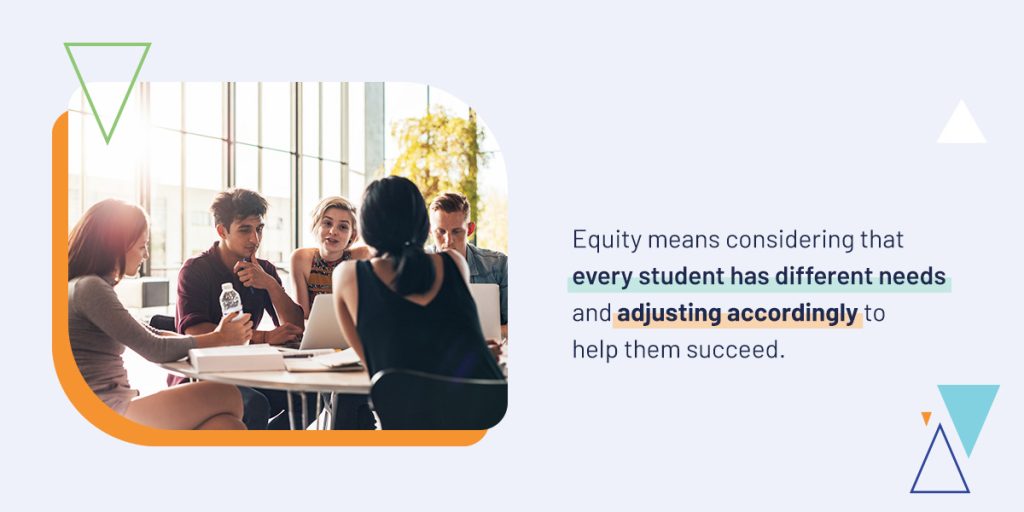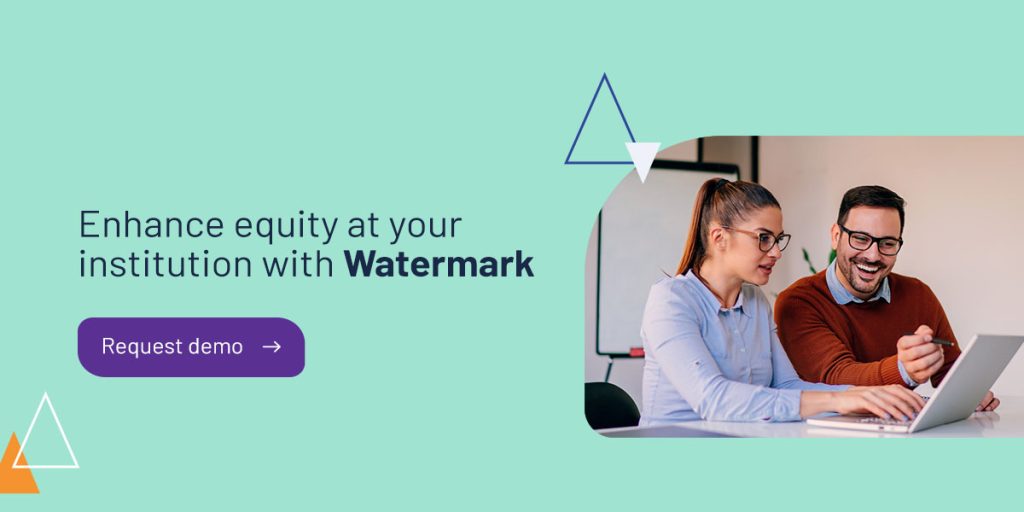
In recent years, the shifting regulatory landscape affecting diversity, equity, and inclusion (DEI) policies in American higher education has revived a sense of urgency in conversations about equitable education. But many institutions find it challenging to understand what educational equity looks like in practice, how to achieve it in today’s legal and political context, and why equity initiatives still matter. This guide explores what equity means in schools today and why it’s important for your institution.
Defining equity in education
One thing that most Americans can agree on is that education should be equitable. But what exactly does that mean? Equity in education can be challenging to define, but for many, it involves custom solutions for funding, resources, or academic support, depending on the student’s specific needs. However, the overarching purpose of equity in education is fairness — ensuring each student receives the support they need to succeed.
Equity initiatives aim to use this support to offset the impact of persisting socioeconomic inequalities on student outcomes. For example, Black students have the lowest six-year credential completion rates of any ethnic group because of extracurricular responsibilities, financial disadvantages, and experiences of discrimination. Achieving equity in education would involve closing this gap.
Equity vs. equality
While equality and equity are often used interchangeably, there are significant differences between these two terms. In an equality-focused classroom, all students have the same educational opportunities throughout their higher education careers.

Equity means considering that every student has different needs and adjusting accordingly to help them succeed. It focuses on taking the opportunities presented to students and providing them with the specific support and resources they need. This means disadvantaged students receive the same opportunities as their peers, plus the tailored help they need to realize their potential.
The changing face of America
America is becoming more diverse. By 2020, almost 40 percent of the total population of the United States, and more than 50 percent of the population under age 16, identified with a minority race or ethnic group. Fittingly, there has been a steady rise in higher education enrollment for students of color. Given the changing demographics in the US and in higher education, institutions need to examine their programs and practices to ensure that all of their students have access to what they need to succeed.
Equity-mindedness in higher education
Equity-minded higher education leaders understand the history of exclusionary practices and the lasting impact of this history on institutions and students today. These leaders recognize the contradiction between the ideals of democratic education and the social, institutional, and individual practices that contribute to persistent inequities in higher education outcomes. They also take responsibility for driving systemic transformation toward equity, starting at their own institutions, to make quality learning for the nation’s underserved students a shared priority.
Why is educational equity important?
Getting a higher education degree can have a great effect on a person’s trajectory. Research shows that earning a higher education degree can:
- Increase a student’s likelihood of being wealthier than their parents.
- Equip a student to earn 75 percent more than someone with only a high school diploma.
- Improve a student’s long-term happiness and health outcomes.
With these benefits in mind, institutions have a duty to ensure that all students have equal access to successful academic achievement. Equity in higher education can be a driving force for equity in our broader society by empowering low-income and minority students to close the economic achievement gap.
Why is diversity important in higher education?
Many higher education institutions agree that providing a diverse experience allows them to fulfill their overall mission of offering high-quality education because equity:
- Enriches the educational experience: We learn more from individuals whose experiences, beliefs, and perspectives differ from ours, and these lessons are more effective in a diverse intellectual and social environment.
- Promotes personal and social growth: Encouraging diversity aids in challenging preconceptions by facilitating critical thinking and helping students learn how to communicate with people of various backgrounds.
- Strengthens communities and workplaces: A diverse higher education experience encourages students to become good citizens in a complex society by fostering mutual respect and teamwork and building a community where members only judge one another on their character and contributions.
- Enhances economic competitiveness: Remaining prosperous in the 21st century requires all companies to create work settings that celebrate individuals from various cultural experiences and backgrounds.
Who benefits from diversity in higher education?
All races can benefit from diversity in higher education. Interacting with diverse peers in a higher education setting can enhance a student’s open-mindedness and understanding of their course material. Students become better scholars and citizens by engaging with diverse peers both inside and outside of a classroom setting.
Students who interact with diverse peers are:
- More aware of their own biases.
- More engaged in their learning experience.
- Better prepared for diverse workplaces.
Creating equity in higher education
For many institutions, affirmative action in student recruitment was a primary strategy for promoting equity until the Supreme Court’s 2023 finding that race-conscious admissions policies are unconstitutional. In light of this decision, equity-minded institutions must prioritize attracting minority and low-income applicants, improving outcomes among these students through support resources that meet their distinctive needs.
One proven way to increase student retention and positive outcomes, especially among minority students, is through student success coaching.
Student success coaching looks at the whole student. It considers their academic and financial challenges on campus but also what their lives are like outside of the classroom. Do they have jobs, family commitments, or health issues? Are they facing housing issues or food insecurity? Success coaching programs take all of these factors to create a personalized advising experience to assist students through their time at the institution.
Success coaches also enable students to have a single point of contact who can connect them to resources throughout the learning institution and the community. These contacts can help students with everything from financial aid services to housing, food, transportation, and child care. Success coaches guide and support students through their academic journey.
Learning institutions with success coaching programs to enhance equity on campus have realized successful outcomes. A First-in-the-World study found that success coaching resulted in Black students being 8 percent more likely to remain enrolled for a year and 18 percent more likely to stay enrolled for two academic years.
Enhance equity at your institution with Watermark

Investing in equity in education is essential to building a fair, thriving society and promoting the success of all students. If you want to enhance equity at your institution, try Watermark Student Success & Engagement.
This student success solution harnesses predictive analytics, early alerts, and mobile-friendly scheduling to help your institution support the students who need help most. A landmark three-year study found that, combined with success coaching, Student Success & Engagement yielded a 22.4 percent increase in retention for minority males. Our data-driven student support technology can help your institution achieve equitable success, too.
Request a free demo today to see how Student Success & Engagement can help all your students realize their potential.

















































































































































































































































































































































































































